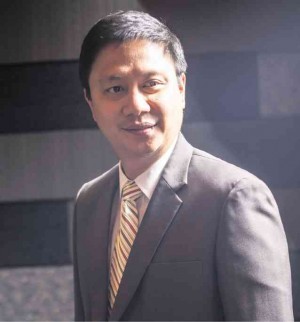New PBA chair has big dreams

ALL FOR ONE for a slam-bang 40th PBA season are members of the PBA board of governors (from left) Silliman Sy (Blackwater), Rene Pardo (Purefoods), Manuel Alvarez (Barako), Ginia Domingo (KIA), Richard Bachmann (Alaska), commissioner Chito Salud, Robert Non (San Miguel Beer), Mamerto Mondragon (Rain or Shine), chairman Pato Gregorio (Talk ‘N Text), Ramoncito Fernandez (NLEX), Eric Arejola (Globalport), Alfredo Panlilio (Meralco) and Alfrancis Chua (Ginebra). The league hopes to grow even bigger under the leadership of Gregorio (right photo). AUGUST DELA CRUZ
IN A DIMLY lit restaurant on an almost obscure street off a main highway in Incheon, South Korea, Patrick Gregorio pondered on a question on how far the Philippine Basketball Association can go now that it was about to unveil its 40th season.
After much thought, the Talk ‘N Text governor replied: “As big as its leaders want it to be.”
Well, he’s a leader now. How big does Gregorio want the PBA to be?
“Really big,” he said.
If you want to quantify what “really big” means, try thinking continent-sized.
“We’re looking at ‘PBA Asia’ as a way of expanding our brand across the continent,” said Gregorio, who was also part of the country’s boxing delegation to the 17th Asian Games.
Gregorio wants to expand the roster of PBA players to Asian and Southeast Asian standouts, not only as a means to breach international markets as far as the PBA teams are concerned, but to open the eyes of Filipino basketball fans to other brands of basketball.
“It just makes sense to thing globally,” Gregorio said. “In an age when we’re preparing for the Asean integration and when everybody’s so interconnected, the PBA has to learn to keep up with the times.”
But to fulfill dreams of such proportions, Gregorio admits he will have to work really hard.
The PBA’s central power, the group that makes the decisions that chart the league’s direction, is made up of different individuals, each one looking after the interests of the team he or she represents.
That can be a problem for a chairman who needs everybody’s go-signal to get such a plan running.
Gregorio is hoping he can muster enough support from the board to inject full-blooded foreigners into the league—not as imports.
According to Gregorio, the PBA could first test the waters by hiring one Asian player per team and then see the reaction it will get, both from the public and from the corporations that will tune in to the development.
“Think of it this way: If we have a Korean player here, what would stop the likes of Samsung, Kia, from investing in the PBA,” said Gregorio, who added that several teams in the PBA already have international business links, thus providing them a new marketing avenue to explore.
Gregorio hopes that the league can raise the number of Asian players per roster in time with its planned expansion to at least 16 teams to soften the talent drain new clubs normally face when joining the PBA.
“There are already plans to expand to as many as 16 teams,” he said. “Now let me ask you, what do you notice when expansion teams are added to the league? These teams find it hard to form a competitive squad right away. They have to go through a building process.”
If teams can hire two or three Asian players each, it will be easier to spread talent around even when expansion squads arrive.
“We can have an even more balanced field even with new teams around,” he explained.
For so many years, the legacy PBA chairmen leave behind is an increase in league profits and live audience. Gregorio, who will hope to do the same, wants to add to that.
“It’s time to have the mind-set that it’s no longer enough to ensure the success of the league during a season,” he said. “It’s time we set the stage for the future of the league.”
“Having players from all over Asia will expose us to a lot of styles of play, it will improve our level of basketball. For the longest time, one of our major flaws is that we are so used to playing against each other. With Asian players, we will get used to playing against different styles,” he explained.
Gregorio is confident that the PBA can compete with other top-notch leagues in Asia for the services of talented players of the continent.
“It’s just a matter of getting things started,” he said.

